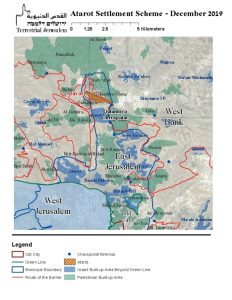For years, a conceptual plan for the construction of a new large settlement neighborhood for ultra-Orthodox communities on the site of the now defunct Qalandia Airport has been under deliberation in the Jerusalem Municipality and the Ministry of housing. It now appears that the plan is about to be seriously pursued in the near future.
 New announcement – The housing ministry has announced its intention to commence in the months to come the statutory planning for 11,000 housing units on the former site of Atarot airport in the northern reaches of East Jerusalem, bordering on Ramallah.
New announcement – The housing ministry has announced its intention to commence in the months to come the statutory planning for 11,000 housing units on the former site of Atarot airport in the northern reaches of East Jerusalem, bordering on Ramallah.- Past attempts to advance the same plan – This plan is not new. In 2012 and 2017, there were sporadic, behind-the-scenes attempts to facilitate the plan. For example, as far back as April 2017, the Minister of Housing, Yoav Galant (Likud), announced his intention to advance the construction of 10,000 units in Atarot, and declared :”We must establish our hold on Jerusalem, from Ma’aleh Adumim in the east to Giv’at Ze’ev in the west, from Atarot in the north to the Bethlehem area and Rachel’s Tomb, to the outskirts of Efrat and Gush Etzion. It has historical, strategic, and moral importance”. Until now, the scheme has remained a general concept, not ripe for the approval process. If the decision to proceed with the plans is implemented, this will be the first time that the plan will be working its way through the planning committees, towards implementation.
- What would be the implications of construction in Atarot – As we reported then, the implications of this project are not to be dismissed as this is a project that could have ramifications similar than the construction of E1. Hence, as we wrote in 2012, “If this plan is actually carried out, the implications for the two-state solution will be extremely serious. Not only will the project destroy the chances for the Palestinians to have their own airport anywhere near Jerusalem, but the project will – in a manner much like the E1 plan – block contiguity between the West Bank and any future Palestinian capital in East Jerusalem. It will effectively form a buffer between Palestinian neighborhoods of East Jerusalem and this area of the West Bank (Shu’afat and Beit Hanina from the south; Bir Nabala, Al Judeira, Al Jib, Rafat and Qalandia from the west; Ar-Ram, Dahiyat al Bareed and Jaba’ from the east; and Qalandia Refugee Camp, Kafr ‘Aqab and Ramallah from the north) and Ramallah. It will turn many of these neighborhoods into ghettos sandwiched between Israeli settlements to the north (Atarot), east (Pisgat Zeev, Neve Yaacov) and the West (Givat Zeev, Ramot).”
How significant is the Atarot announcement? The planning and construction of a new settlement neighborhood in this location will be quite complicated, and will require years of deliberations before the statutory Planning Committees grant their final approval. In that sense, the threats posed by the Atarot settlement scheme are by no means imminent.
That said, efforts to thwart the implementation of the Atarot scheme need to commence forthwith. This is by no means a routine settlement scheme, and the construction of this settlement neighborhood will, like E-1 and Givat Hamatos, have a devastating impact on the very possibility of ever arriving at a permanent status agreement.
We often find ourselves trapped in a paradox relating to East Jerusalem settlement schemes. When the plan is to be implemented in the distant future, the thinking is often there is no need to expend precious political capital on something that hasn’t happened yet. And when the plan is approved and tenders published, the thinking is that it’s too late, and the “point of no return” has already been crossed.
Consequently, there is no such thing as a “window of opportunity” in Jerusalem unless one creates that opportunity. Our experience is that plans such as these need to be flagged as the “doomsday settlement” that they really are, and the early the engagement the greater the prospect of succeeding in thwarting the scheme.
